|
FAQs on Aquatic Insects and Freshwater
Aquariums: Aquatic Flies of
All Types
(Caddis, Gnats,
Midges...) Related Articles:
Invertebrates in Freshwater Aquariums,
Invertebrates for Freshwater
Aquariums by Neale Monks,
FAQs on Aquatic Insects:
Aquatic Insects 1,
Aquatic Insects 2,
Aquatic Insects 3,
Aquatic Insects 4,
Aquatic Insect Identification,
Aquatic Insect Control
FAQs on Aquatic Insects by Group:
Beetles, Dragonflies,,
Freshwater Mites,
Mosquitos/Mozzies and much more!
|
|
|
Midge Larva control 2/21/17
Good Morning,
I have spent countless hours here and on Google trying to solve my problem.
I have identified what I think is midge larva in my tanks, first they were
in my sponge filters, which I removed and cleaned replaced with hang on the
back filters. Now they are back, which are driving me crazy!
<Mmm; windows screened? The adults are getting in somewhere>
I have a 30 gallon tropical tank with 6 Cory catfish and 7 neon tetras, in
this tank I never see them free swimming, however they are in the filter and
filter media. Within days I can see their little casings in the media and if
I rinse the sponges there are hundreds of them!
My second tank is a little more of a pain, in it a have an adult axolotl and
the larva are in everything. Sand, filter, sometimes on the glass resting.
I’m assuming this is because my axolotl is too big to make a snack of these
critters. Everything I have read says they make good free foods and to leave
them however, larva turns into something, and I do not want an infestation
in the rest of my house!
I also have two 10 gallon tanks in another part of the house with two
juvenile axolotl that is completely healthy and pest free, just these two
tanks in my basement living room.
How can I get rid of these things for good?
<For good? Really, the only way is to remove the life you want to keep and
"nuke"; likely bleach all (There's an S.O.P. on WWM Re)... Then rinse,
refill, move some old media, gravel from the upstairs tanks to the ones in
the basement to establish cycling and... start over from there. Otherwise,
you could try relatively arthropod-toxic treatment/s... or possible
predators. BUT, you've got to fix however adult flies are getting into the
tanks>
I am constantly changing water and filter media to control the numbers but
never see flies, just the worms in the filter and axolotl tank.
I greatly appreciate your advice,
Mandi
<Sure. Bob Fenner>
Updated: midge larva control 2/21/17
* I apologize, I forgot to attach the photos I was able to take of the
larva.
<Got them. Thanks. BobF>
|
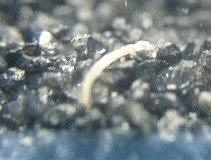
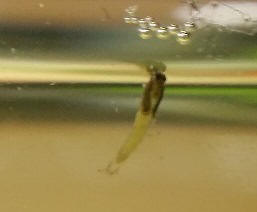 |
|
What is this? 5/30/15
I have put an avocado pit in water and after a few weeks, I found these worms in
the water. The most pointy side are mostly at the top of the water, as if for
breath!
<Can't really tell from your photo but description matches "rat-tailed maggots"
which are the larval form of specific types of fly and very interesting beasts!
Not many people get to see them, so well done! Probably better outdoors in some
swampy bit of pond though. Cheers, Neale.>
|
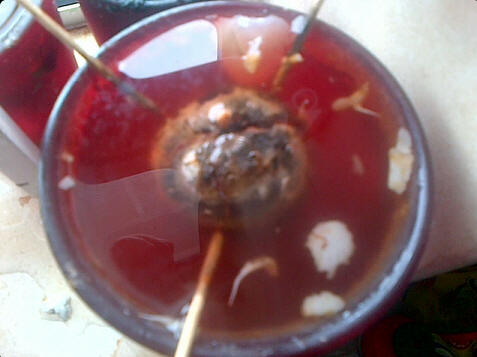 |
|
Strange worms in tubes and algae
3/13/15
I have a newly planted freshwater aquarium with no fish. I have a few Amazon
swords, crypts, and Anubias plants. I have 2 t5 fluorescent grow lights. My
planted tanks has some kind of dark green algae with squiggly lines and with
some kind of worms. The worms are growing in some kind of single tube.
<Indeed! Sessile chironomid larvae or similar. Also an Hydra visible in one
photo, the branched, off-white tree-like organism.>
The worms poke their heads out of tube for a few seconds and then go back in the
tube and hide.
<Yes.>
I can't find anything like them on the internet and was hoping you might be able
to tell me what they are and if I should get rid of them and is it safe to put
fish in the tank with them?
<Harmless filter-feeders; fish food. The hydra is a bit more of a risk in a
breeding tank (will catch, eat tiny fry).>
Here is a couple of pictures. Thanks in advance for any help you can provide.
Sincerely, Robert.
<Most welcome. Neale.> |
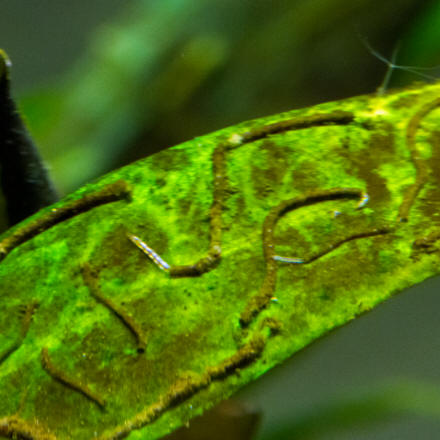 very nice pic.
very nice pic. |
|
Wormlike wigglers in cycling tank
/Neale
2/19/15
Can you guys identify what these are? They appear to be little white
worms in the water but zoomed in they look like larvae of some type.
This is in a new setup about 4 weeks old, no fish, fresh black onyx
sand, RO water, and 81 degree temp. They seem to have come out of no
where. Thanks in advance. Video below image.
<Midge larvae or something similar. Totally harmless, and likely fish
food if you add anything insectivorous of appropriate size (such as
tetras). Not mosquitoes, anyway, which attach to the surface film of
water. Cheers, Neale.>
Wormlike wigglers in cycling tank /RMF
2/19/15
Can you guys identify what these are?
<Mmm; yes>
They appear to be little white worms in the water but zoomed in they
look like larvae of some type. This is in a new setup about 4 weeks old,
no fish, fresh black onyx sand, RO water, and 81 degree temp. They seem
to have come out of no where. Thanks in advance. Video below image.
<Insect larvae... heads appear too small to be mosquitoes, maybe Midge
larvae. I'd net out, remove. Bob Fenner> |
.jpeg) |
|
Re: Wormlike wigglers in cycling tank
2/19/15
Bob,
Thanks for the reply. I added what is now a very full and satisfied
Platy to the tank.
<Heeee! I bet!>
The thing couldn't get to the little morsels fast enough. Happy to say
that all wigglers are gone.
Thanks again.
<Cheers Mark. BobF> |
|
Could you all please I.D.
1/1/15
Any clue? I've asked around, yet nobody seems to know.
<Mmm; would like a bigger, better resolved pic... My initial guess is
that this is a juvenile Tunicate, a larval
Ascidian of some kind/species.
Bob Fenner> |
 Re: Could you all please I.D.
1/2/15
This is the best I have
<Video clip>
I had gotten rid of him, I didn't want him to harm my tank.
<Won't>
Thanks for getting back with me bob fenner
<My guess is still on the Thaliacean. BobF>
Inputs for Bob (Re:
Could you all please ID dated 1/1/2015)
1/3/15
To my Kumpadre Bob,
<Hey Rix!>
Hi! I hope you and the crew had a great time during the holidays. I'd like to
chime in on the erstwhile unidentified organism in the letter dated 1/1/2015. No
info was given regarding the habitat, but if it was collected in freshwater, it
might be a rat-tailed maggot.
<Just looked up; neat!>
I had fun collecting these in anoxic creeks during my younger years in Manila
(gosh the memories haha). Hope this info helps. Thanks for all the help you and
the crew have been providing all these years, and wishing you all the best for
2015.
Salamat!
Rix Pavia
Manila
<Mabuhay mi pare jo! Bob Fenner> |
|
Weird Things in my Tank 11/6/14
Hello, my name is Brooke. I'm writing in regards to these strange
creatures
I found in my boyfriend's fish tank. He has a 29 gallon tank that was
purchased on September 27th. He currently has 3 Gold Danios and a
couple snails. He's waiting for the tank to
cycle before adding other fish. The PH is
about 7.2. The ammonia fluctuates between 0 and 0.25, the Nitrites are 0
and the Nitrates are at 40. He's new to the hobby, but has done
everything according to what the people at our
local fish store have recommended. He keeps
the tank at 76 degrees. He has an Aquaclear 30 filter. He has live
plants that were purchased at the time of the tank, before the
fish. He has, I believe, Fluorite Black
substrate mixed with a little black gravel.
We do weekly 10% water changes. During the water change, he suctions the
substrate as well as he can without digging up plants. I'm not
sure if all of this is useful to you in
helping to ID these creatures, but figured it
would be better to include it, just in case. I noticed the creatures
about a week ago. They looked like small bits
of root coming off some of the plants that
have been floating at the top of the water. The creatures were
green in color, small, and long. After closer inspection, I saw
that there were also some that were a little
larger and brown. I did some research (days of
pouring over Google as well as your site) and couldn't find
anything other than maybe a Damselfly Nymph, but still felt like
it was unlikely. I decided to watch and see
what happened. As they got larger, they
started to look like they had little bug or shrimp bodies sticking out
of the long, skinny, brown "shell," and I could see a "vein"
pumping through the "shell." They also look
like they have a long piece of plant root
attached to their top sides. They don't seem to have a preference as
to which portion of the tank they are in, as long as they are on
something.
I've seen them on plants at the top, walking on the walls, and walking
along on the bottom of the tank. Although, they do seem to like
being on the plants the most. I tried to get a
few pictures of them, though it's
hard as the biggest are only about an inch in length. I'm including a
picture of a smaller one as well as a close up of a larger one
from the top and a larger one from the side.
My main questions are: What are they? Are
they safe to keep? If not, what should I do?
If they are, is there anything
I need to know about their care? I've found them quite
interesting to watch, so I'm hoping they are
keepers. Thank you so much!
<The photos aren't sharp, so can't be sure. But are these Caddisfly
Larvae or something similar? That's what they look like to me. They're
hugely diverse, including some species that eat algae, some that feed on
particles of organic matter, some that capture small invertebrates such
as other insect larvae. I can't think of any that eat fish, and they're
so small none should be a threat to anything bigger than, say, fish fry
anyway. So you might want to observe this beast a while longer. Look up
Trichoptera in your local area and see if any match the animal you have
here. Cheers, Neale.>
|

 |
|
Re: Weird Things in my Tank 11/6/14
Thank you so much! It looks like that is exactly what we have. I suppose
we'll watch them, and once they have emerged from the water, we'll
catch them and let them go outside. They're really
quite fascinating! It's hard to believe they've
built their cases out of stuff they've found in the tank!
I really appreciate all your help as well as your quick reply!
Thanks!
Brooke
|
|
FW parasite ID 8/18/13
Good morning
<And you>
I wondered if you could help with identifying the attached...
I found 8 of them on the bottom of my quarantine tank after treating a
sick platy with an anti-parasite medication (liquid Praziquantel 'Prazi
Pro') . As far as I know they came from inside the poor fish.
<Mmm; appear to be chitinous in this pic... external, or gill cavity
(which is also ext.)...>>
The heads are dark and visible to the naked eye. About 0.3mm across. The
bodies had largely disintegrated before I got them but looked to have been
maybe a cm or so long and worm-like...
<Hmmm; please do send along an image of a whole specimen if you can>
without the dark cuticle (?) visible on the head part. I did see some other
structures - a node with fine hooks or hairs (bursa? couldn't tell which
part it had been attached to) and the structure coming from the inside of
the head shown on the doc. file.
Hunting around on the web the closest I can find is some kind of hookworm
... what do you think? The teeth and claw structures are really distinctive
but I couldn't find a picture of anything quite like these anywhere...
I'd like to know what they are and whether my main tank is likely to be
swarming with eggs and larvae just waiting to latch onto one of my other
fish and whether there is any point in re-treating my sick fish with the
Prazi Pro - she is still very sick-looking and not eating. (It is 7 days
since I first quarantined and treated her)
<If they are worms, the Prazi has likely eliminated them; if crustaceans;
you'll need to treat w/ another compound. See WWM re such for freshwater
fishes.>
Any help/info would be appreciated!
Sarah
<The head, mouth parts, are reminiscent of Ergasilus, some other copepods...
perhaps... Bob Fenner>
|
.jpg)
.jpg)
.jpg)
|
Re: unknown parasite, FW...
8/18/13
Thanks for the quick response! Had a look at Ergasilus spp on the web -
but nowhere seems to mention they have 'teeth' - which are very
distinctive in the species I have and I think would be commented upon
somewhere...
<Mmm, yes>
I have make the attached composite photos of the 2 specimens I have of
bodies ('body 2' has two versions - a light and dark)... I am afraid
both specimens are in pretty bad shape but I had another good look under
the microscope and can't see any obvious structures like legs or chitin
plates etc... so don't know if these help much! I am also not sure if
they are complete or the tail end has broken off - looks broken to me so
there could be missing parts.
<... no apparent legs? Quite common in internal parasites; and of course
worms lack them... But do have eyes; and these too tend to be absent, or
greatly reduced... These appear to be segmented... and still
arthropods...
Did you actually see them being evacuated from the fish's vent?
Am leaning toward (guessing) aquatic insect larvae...
non-parasitic; though can be piscivorous... Do put the string
"freshwater aquatic insect larvae" in your search tool and take a long
look/see at images... do any of these bear close resemblance to what you
have here?>
Sorry about the quality - I am just holding my camera and taking shots
down the microscope tube.
<Good work; better than I could do. BobF>
Sarah
|

 |
Re: unknown parasite
8/18/13
Oh - that's an idea! I'll send the photos to a friend who is an aquatic
invertebrate person... though I have to say I still think they must be
parasitic. I scooped the sick fish out of the aquarium in a small container
to transfer her to the quarantine tank and I think I would have
noticed if these guys were with her. But maybe not! Perhaps there is
something else completely different wrong with the fish...
Sarah
<... do look at the system this fish was hauled from... At the surface
especially. B>
Re: unknown parasite
8/18/13
I agree - the mouthparts do look like those of an insect....
Any suggestions as what to do with my sick fish? Any other treatment (if it
's not an internal parasite) you can suggest?
<As you were first directed.>
Symptoms are - very thin, lethargic, not eating or if eats - spits food out,
has been like this for at least last 2 weeks (was away on vacation before so
not sure how she was...), other fish in original tank all fat and bright,
can't see anything obvious on her externally....
Sarah Re: unknown parasite
8/20/13
FYI Identified the mystery 'parasite'
It's a midge larva!
<Aha!>
Not a parasite at all but residue from feeding bloodworms... must have
been in the water the fish was transferred in (from the main tank) or
from her gut and pooped out once in the quarantine tank...
<Ah yes; as I had guessed>
Back to the drawing board for my diagnosis!
Sarah
<No worries; not harmful. Bob Fenner>
|
|
Planted Tank, fish sel. for pest control
11/9/11
Dear WWM,
Usually this would concern marine topics, however I do have a 20 gallon
freshwater planted. My goal when I purchased it was to make a tank that
would be almost self sufficient, obviously it needs water added on
occasion due to evaporation and flow provided, my end product has a
small heater, and filter, and standard light (also receives ample
sunlight). Stocked with Micro Sword which is growing across that tank;
Amazon Sword that has more than doubled in size and number of leaves;
Argentine Swords which grow and are a nice back drop, Java Fern slow
growing, and what I believe to be a Ludwigia peruensis that likes to
loose leaves every time new ones grow in.
I also have two Apple Snails, Six Ghost shrimp that keep having babies
whom I can never find. I would assume this is due to the free swimming
larva encountering the filter. One common Pleco. I also have gnats that
like to land and die in the water much to my dismay. Is there a
fish I could get that would not have a high demand or be over-whelming
to my tank that would eat the gnats and algae? The algae I
already identified to be Green Spot Algae rather than a
non-photosynthetic type. Thanks.
Bryce
<Depending on water temperature and water chemistry, something from
the killifish or livebearer groups would seem most appropriate here. At
low-end tropical temperatures, Florida Flagfish can make excellent
algae eaters.
They're territorial but not especially aggressive. Other
pupfish-type Killies might be used depending on their availability in
your area.
Livebearers are good for tanks with moderately hard to hard water.
Alfaro cultratus is an exception, doing well in soft water, though it
is difficult to breed and eats mostly insects rather than algae. On the
other hand, Limia nigrofasciata is an excellent algae-eater and unusual
enough that passing on excess fry is easy to do. The Dwarf
Mosquitofish, Heterandria formosa, would be an excellent choice for
your tank, being so small it'd have minimal impact on water quality
unless you kept hundreds. Naturally, you could go with plain vanilla
livebearers too, such as Endler's. Just as an aside, the Plec has
no place in this tank and will cause trouble before long; neither will
it do much/anything to hold back algae. Replace with an Ancistrus
instead; these are smaller, reasonably good algae eaters, and very easy
to keep. Otocinclus might be an option too, but they're delicate,
dislike warm water, easily starved, and often die within a few months
or a year of purchase. Cherry Shrimps are much easier to breed, and
they're also more colourful, and in my opinion the best all-around
shrimps for most tanks. Do bear in mind that Green Spot Algae isn't
going to be removed by any fish. To deal with this algae type, you want
to adopt a preventative approach, perhaps through a combination of
physical removal of what you have now, Nerite snails for scraping away
new colonies before they start, and the use of fast-growing plants
(ideally, floating plants) to inhibit algal growth. Cheers,
Neale.>
|
Freshwater insect larvae ID 6/26/09Crew,
<Hello,>
I mostly tore down my QT tank before going on a work trip 2 weeks
ago.
While I was gone there was gravel enough to cover the bottom and
water to just cover the gravel (maybe 1cm). I was cleaning the
tank today by adding hot tap water and I noticed what I assume
are insect larvae. Sorry the pics are out of focus. The long,
gray UFO (unidentified freshwater object)
is about 1.5 cm actual length. The other 2 are about .5 cm.
<It's the larva of a dipteran of some sort. Midge,
mosquito... something like that.>
No matter what, I plan on having all these things cleared out of
the aquarium before the wife sees them. She hates anything
wriggly!
<They're fish food. Not a problem.>
Thanks for any help.
Evan
<Cheers, Neale.>
|
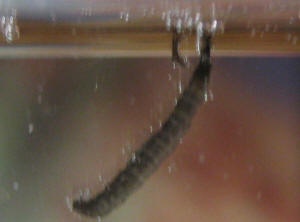
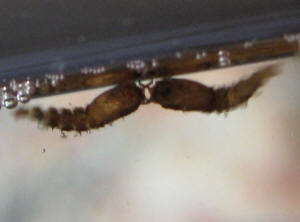 |
Spiders in my silver dollar tank 5/8/2009
Hi guys,
I have Googled till I'm cross-eyed, but still can't find any
advice on a creature I've found in my tank when vacuuming.
It looks like a silver grey spider, body about 5 mm long, 3 mm wide, 6
legs, and is quite active. The total leg span would be about 1.5cm.
<Well, if it has six legs, it's an insect. My guess would be a
Damselfly larva; these are quite commonly seen in fish tanks, coming in
with aquatic plants and portions of live food. They are predatory, but
beyond fish fry, it's hard to imagine them causing real
harm.>
It was cleaning the muck off its feet in the bottom of the bucket and
is quite cute. I'm reluctant to kill it or to put it back incase
it's a parasite and my harm my large silver dollars.
<Damsel- and Dragonfly larvae are indeed fascinating animals, and
easy enough to rear in floating breeding traps. They can be hand-fed
live or (wet) frozen bloodworms using forceps.>
I know they're not in the right tank, I have a large bio-orb, which
is actually difficult to clean as the filter sits in the bottom of the
orb and is quite small, but they grew so quickly, I'll need to buy
another tank.
<I'll say! Just as an aside, BiOrb tanks may look good, but in
terms of fishkeeping, they're very poor value for a whole host of
reasons. Stick to traditional long, rectangular shapes. Avoid anything
tall, round, or otherwise odd in shape.>
My local aquarium isn't much assistance, they couldn't identify
the leech, red thread worms, or little white flea like creatures.
Still, thanks for your advice.
<Happy to help.>
I'm loving owning fish and there's so much to learn. I now have
5 tanks!
Started from one, but fish grew, bred, had personality issues....
I'd better learn quickly.
Cheers,
Lauris
<Cheers, Neale.>
Identify Worm 11/23/08
I live in coastal SC and I kept my turtle tank outside during the
summer and fall. I just brought it in for routine cleaning and because
of cold weather. The tank had some strange "worms" that
looked a little like "naked caterpillars with long string-like
tails." The ones that were moving were a fleshy tan color. There
were also some that were black or dark brown and very hard. Some of
them were in the water but some were attached together by the
"strings" and hanging off of a rock in the tank. I have
looked on many sites and tried many different search terms but am not
coming up with an answer. Please help me identify this strange little
creature. Brandi <Hello Brandi. What you're describing is almost
certainly a "rat-tailed maggot", a distinctive fly larva that
inhabits stagnant water. The long "tail" is a breathing tube.
They're pretty much harmless, and in England at least very common
in small, unfiltered ponds. Fish (and likely turtles) don't seem to
eat them, or at least my fish don't! Cheers, Neale.>
|
Strange Creatures in FW tank 9/20/08
Hi people
On performing a water change earlier today, i noticed a couple of
odd creatures which came from within the gravel of my goldfish
tank. Any idea whether these be friend or foe. Actual size is
around 12mm (½?) in length...
http://fixpix.zoomshare.com/:tools:album?go=proxy:album/Fish/images/661bec64bccf1ba5007686aec62ba640_12218337380/image.jpg
Thanks in advance J
<Hello! This URL asks for a log-in and password. How about
just sending a small (max, 500 k) attachment? That's what
most folks do, and we thank them for it. In the meantime, most
small bugs and worms in fish tanks are harmless. Cheers,
Neale.>
Strange Creatures in FW tank
Hi Neale
On performing a water change earlier today, i noticed a couple of
odd creatures which came from within the gravel of my goldfish
tank. Any idea whether these be friend or foe. Actual size is
around 12mm (½?) in length...
Brad
<Hi Brad. This is, I believe, a Damselfly larvae; looks like a
Dragonfly nymph, but the give-away is the "tail" made
from three filaments. Dragonfly larvae are bigger, have more
robust jaws, and a stubby "tail". Damselfly nymphs are
predatory, but only sufficiently large to take small fish,
perhaps livebearer fry. Otherwise they're fish food! Quite
fun to rear yourself, they can be hand fed bloodworms with
forceps, and it's rather fun to watch their bizarre mouths
anatomy in action. Dragonfly larvae are much more dangerous to
fish, some varieties being anything up to around 8 cm/3"
long (at least here in England) and more than capable of eating
things like minnows. In any case, almost certainly came in with
live plants that were grown outdoors, though possibly in batches
of things like Daphnia. Does rather stretch the imagination to
assume either a Damselfly or Dragonfly flew into your home and
laid its eggs there, but it's possible I suppose! Cheers,
Neale.>
|
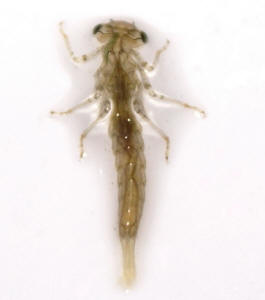
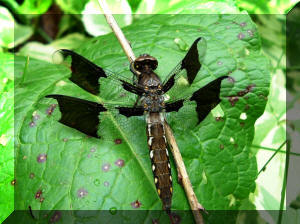 |
|
Re: Strange Creatures in FW tank 9/21/08
Hi Neale
Thank you for the response. Since I only have large-ish goldfish
in the tank, looks like they will not be a problem. I do buy live
plants for my fish to snack on, so I guess that was the ticket in
for the larvae.
Thanks again
Brad :)
<Hi Brad. Those Damselfly larvae should cause no harm to your
Goldfish; in fact I'm surprised they haven't been eaten
yet! Cheers, Neale.>
|
Fly Larvae in Turtle Tank, shoo fly,
shoo 6/29/2011
Dear Crew,
<Hiya! Darrel here>
I have a problem with larvae getting into the filters.
<I hate when that happens>
I know there's been questions like this asked but normally they
describe white circles or worms that swim around in the water and are
parasites.
<A parasite swimming around in the water sounds more like my
brother-in-law on vacation in Hawaii>
I know that the larvae grow up to be some type of flying insect, not
sure what kind but they look almost like fruit flies. So here's the
deal:
<OK>
I have a year 1/2 old Red Eared Slider who resides in a 20 gallon
aquarium with a waterfall type filter and a real log.
<Real wood gets really waterlogged and grows real fungus eventually.
An alternative might be some sort of rock or plasticized wood often
sold in aquarium stores for tank decoration>
There have been dark black-brown worm-like larvae crawling on the
filters when I clean the tank every week 1/2 - 2 weeks. I'm not
sure when they start to develop but by the week 1/2 point there is
normally one or two types of flies surrounding the tank;
<Sounds attractive, huh?>
While some may be getting in from outside and being attracted to the
heat lamp, the larvae have been growing on the filters for a couple
months and the filters have been replaced every time I've cleaned
them. Do you know what this could be caused by?
<Yes>
He eats Omega One Adult Turtle Sticks and the filters seem to have a
type of rock in them and are white rectangles.
<Ceramic cells that encourage bio-filtration>
I'm not sure of the brand at this time.
<Many brands '¦ same stuff>
He was found in a pipeline in a steel mill and rescued by my
half-sister's dad who gave him to us.
<Thanks, Dad!! That was really nice of you.>
Thanks for your help, and sorry if this has been asked already!
<No apologies necessary, Courtney. It happens all the time>
<The answer is most likely that you've never fully killed the
eggs, so some hatch and pupate before you even notice and in turn
mature and lay new eggs.>
<So here's what I'd do: Take Piper ('cuz you'd name
a turtle from a pipe Piper, right?) out of the tank and find him a new
place to live for a few days. Someplace warm and DRY. We're going
to keep him out of water except for 15 minutes a day when you put him
in a shallow container of water with a bit of food. He'll eat &
drink and hopefully he'll poop. If he poops in the container water,
which you're flushing - any eggs in his digestive tract will be
eliminated from the cycle. If he poops in his dry box, the eggs will
likely not hatch anyway, but you're still cleaning that up
daily.>
<Meanwhile, leave his tank intact. Water to the regular
"full" level and maybe even an inch more. Add 1 cup of
chlorine bleach per approximate gallon of water. Even a bit more is OK
as long as you can ventilate the room so no one breathes the fumes.
It's important that you leave the filters on and running during
this process. What we want to do is kill the larvae and eggs everywhere
-- inside the tubes, down in the impeller -- all the places you'd
never reach with even the most thorough cleaning. After 24 hours, you
can drain the water, break the system down and clean everything. Rinse,
use soap and water, rinse again & then set it back up.>
<Let it run clean & sterile for another 3 days, then put Piper
back in. Chances are that you'll have broken the larvae
cycle>
<How was THAT as an answer on a scale of 1 to 10???>
Damselfly nymph 10/10/10
Greetings!
I have a 20g long shrimp only tank with a medium-fine gravel substrate,
planted with Sagittaria, hornwort, java fern (medium density). 2x 18w
bulbs, nothing out of the ordinary. Housing maybe 20 RCS, 15% water
change weekly. pH ~ 7.6, all chemistries 0. I have found myself a
damselfly nymph (am led to believe is this, and not dragonfly, due to
longer, more slender body). Question is, are they detrimental to RCS
population? I have removed one I saw (is roughly 1' long), do not
see others. Is this a 'keep eyes open for more and take out as
needed' deal, or something more drastic? I don't want to break
this tank down for this. Any advice appreciated.
Brandon
<Brandon, Damselfly nymphs are predators, and they will eat very
small animals of all types, including fish fry. Whether they can
actually kill an adult shrimp is questionable, but they might take
juveniles. Of course Damselfly nymphs do need to eat *something*, so
unless you're providing suitable live or wet-frozen food for them
-- they suck the juices out using their jaws -- it's probably best
to move the nymph to a pond nearby. They're neat animals, and the
adults are beautiful and in some cases endangered. One last thing,
Damselfly nymphs are distinct from Dragonfly nymphs in having three
breathing tubes at the tail-end of their abdomen, structures that
Dragonfly nymphs lack. Cheers, Neale.>
Re: Damselfly nymph 10/10/10
Indeed a damselfly nymph then.
<Good.>
I have moved said nymph to another location, but in the absence of
naked-eye visible ones, is it likely there are more?
<Unlikely. This is indoors? Unless you have damselflies flying
around your home, it's most likely this one came via plants or live
food, both of which can be cultivated outdoors or in large glasshouses
where damselflies might be buzzing about.>
I suppose it's just a keep watch, remove as needed affair?
<Yep.>
Probably half my shrimp are berried at various stages, so I don't
believe population-wise the nymphs will pose an issue, unless they
appear in large numbers. Just keep eyes open and remove PRN?
<Pretty much. They're such neat animals, you might even choose
to keep one as a pet. Some remain in their nymph form for months, even
a couple of years, depending on water temperature. I've used
forceps to feed them wet-frozen bloodworms, and various small live
foods such as glassworms will be taken, so they aren't difficult to
maintain. Cheers, Neale.>
identity of small black wriggly worms/larvae
9/17/10
Hi! We're currently residing in Manila, Philippines. It's
happened twice already wherein we found more than a dozen thin black
wriggly larvae on the countertop of our bathroom sink. It seems like
they just magically appear out of nowhere.
<Almost certainly some sort of Dipteran larvae.>
They wriggle their heads and tail ends from side to side. Really
gross!
<Nothing in nature is "gross", merely different.>
I'm afraid they're harmful parasites.
<Very unlikely.>
I'm worried for my kids.
<Don't be.>
Help! What are they? And how do we prevent them from reappearing.
<Dipterans tend to be attracted to moist, warm places with organic
matter on which they can feed. There are many types of Dipteran,
including things like house-flies and mosquitoes through to more
obscure species. Dipterans dislike dry houses with nothing for them to
eat, and the are eaten by spiders and carnivorous plants. So there are
some clues there about what you can do to minimise problems with
Dipterans.>
Thanks so much for your help!
<Please understand we aren't environmental health consultants;
we're fishkeepers. If you're concerned about pest animals
inside your home, you need to speak to genuine experts. Only your
doctor will be able to tell you if these organisms are a threat to your
health, and only pest control professionals will be able to determine
why these animals are getting into your home. So take my diagnosis for
what it is, speculation on the part of a non-expert. In no way is
WetWebMedia liable for any health or other problems caused by these
larvae or your subsequent actions. Cheers, Neale.>
|
Worm Identification 8/30/10
Hello,
I found a worm in my drinking glass this morning. I assume it
came in through my tap water. Could you help me identify it?
Thank you.
<It's not a worm; it's an insect. Some sort of
Dipteran larvae, e.g., a midge. Harmless, and an excellent fish
food! Cheers, Neale.>
|
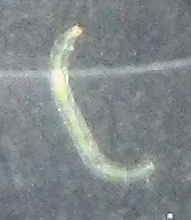
 |
|
Red Worm ID (Royal Plec) 11/19/07 I've
had a 3 1/2" Olive Royal Plec alone in quarantine for 10
days or so. I dewormed with Praziquantel last week at the
recommend dosage (76 mg/10 g) as I know they're wild caught
and don't want to pass anything onto my own fish. He went
into a 20 gal tank with new aged water and a fully cycled Penguin
280 bio-wheel filter from another tank. I did his 25% water
change today (after leaving the Praziquantel in 5 days) and found
these live red worms (pic attached) in the water I syphoned off
the bottom of the tank. Pretty wiggly and entertaining under the
microscope but I can't figure out what they are via the
FAQ's. If they weren't alive I'd have thought they
were frozen bloodworms. I'm hoping it's a harmless worm
that can be treated as the Plec is eventually going in with my
much loved Severum. I promise not to bother you anymore, but
maybe the picture will help others. Mitzi <Looks like a
chironomid larva (a.k.a. midge larva or bloodworm) to me.
Probably got in with some live food. Usually get eaten by fish,
so not common in aquaria. But if this tank was empty for a while,
then it's possible a midge laid some eggs there. In any case,
harmless. Cheers, Neale.>
Re: Red Worm ID (Royal Plec) 11/19/07
Thanks, Neale. I feel stupid then but thankfully that's good
news. I never feed live food, but the driftwood in his tank had
been soaking for a month in a large kiddie pool outside. I rinsed
it off real well but I bet that's where the bloodworms came
from. (The tank had been empty and stored before he went in it).
What a relief! Mitzi <Mitzi, Glad we have a happy ending here!
Cheers, Neale.>
|
|
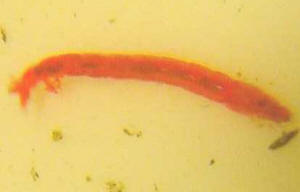
|
|
|

